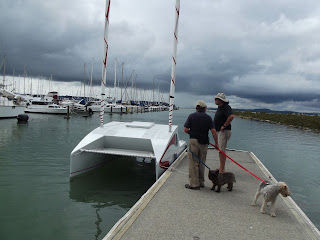Feb 2015
Details of my bow net. I almost was not going to bother with
it but I am glad now I did because without it, it would be impossible to get on
board the boat from the front, even at a beach.
The small tubes mounted on the inner hull
sides , get notched out at about 150 mm spacing, and a fibreglass rod about 4mm
diameter is inserted. The lashing from the bow net goes round the rod, back out
again and onto the next notch and so on. I made the profile of the net myself
by taking a pattern of the bow net space on the boat, minus 50mm all round. After
taking it away from the boat I put small nails round those lines and loosely
stretched out the netting. Then I put 6mm diameter glass rod round the edge line and tied the
netting round that with 2 rows of knotting , all while still stretched on the
pattern. Then I trimmed the excess of with a hot knife . Leaving it all
attached to the pattern boat I took it back up to the boat and with adjustable
saw tables raised it up into position. Then I temporarily attached it with
plastic cable ties, pulled the pattern piece out from underneath, and tied off
the whole thing to the boat as per the photos. I should have taken a photo while
it was still on the frame but forgot.
Testing out the furling and sheeting of the sails on the
grass at home. Everything works. I have subsequently made a mast raising jig
which keeps the mast vertical whilst preparing to lower it into place.
A word about the sails: There are several options for sails
in the plans, depending how technical you want to get, and it is even possible
to use large windsurf sails. In the end I decided to go with the system similar
to that used by Hobie in their Bravo catamaran and AI outriggers. This is one of the options Bernd suggests with the boat.
The long angled battens are 7 mm fibreglass rod and they are flexible enough that they bend round the mast when the sail is furled. The masts turn in the mast holders (see earlier photos of mast base) and the furling and unfurling takes just a few seconds, per side. I also wanted to try a boomless set up and so I had to supply to the sailmaker a lot of measurements of the boat , masts, and various heights and spacings so that the clew of the sails would finish up with an even pull , both downwards and outwards when the sails are sheeted in. Worked out well for up wind sailing but I am experimenting with poling out the leeward sail when reaching to maintain better sail shape.
The long angled battens are 7 mm fibreglass rod and they are flexible enough that they bend round the mast when the sail is furled. The masts turn in the mast holders (see earlier photos of mast base) and the furling and unfurling takes just a few seconds, per side. I also wanted to try a boomless set up and so I had to supply to the sailmaker a lot of measurements of the boat , masts, and various heights and spacings so that the clew of the sails would finish up with an even pull , both downwards and outwards when the sails are sheeted in. Worked out well for up wind sailing but I am experimenting with poling out the leeward sail when reaching to maintain better sail shape.
I made a plywood rear mast holder to go with
the factory built front holder on the trailer, installed an outboard motor
bracket on the boat. I had hoped to avoid having a motor but in the end decided
it was worth having one. The 3.6 hp motor provides more than adequate power and
the tilting bracket puts the prop plenty deep enough.
Launch day (finally) The boat floats well above its water
line till Greg and I hop on both at the stern.( Must go back to the gym soon)
We spend a few hours happily coming to terms with the intricacies of the
biplane rig in light winds, and then sail back to Westpark Marina and pack up
just as easily as the launching itself. I think soon I will be able to manage launching on my own. Of course sailing single handed is easy.
Index of materials (to follow)
Epoxy
Glass cloth
Windows and hatches
paint
masts and spars
sails
sheeting hardware
trailer



















































